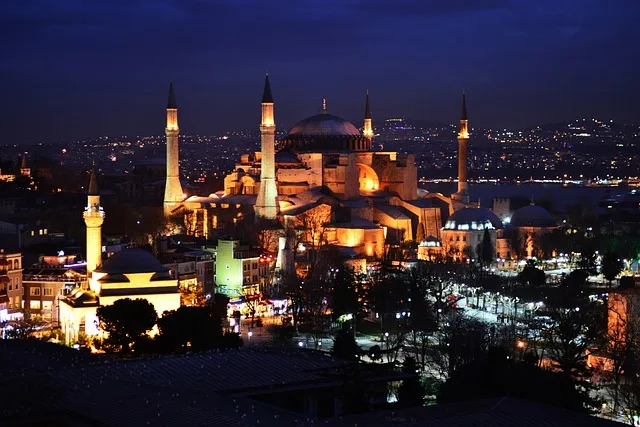
Built in the 4th century, Hagia Irene was originally a church and later transformed into a museum. Its name translates to “Holy Peace,” and you can almost feel that serenity as you walk through its grand entrance. The moment you step inside, the soft light filtering through the windows casts a warm glow on the intricate mosaics and stunning architecture. It’s like walking into a painting, where every corner tells a story of faith, artistry, and resilience.
What sets Hagia Irene apart is its remarkable acoustics. Have you ever been in a space where your voice seems to dance in the air? That’s what happens here! The sound of a whisper can resonate beautifully, making it a favorite spot for concerts and cultural events. It’s as if the building itself is alive, breathing in the music and history that surrounds it.
Unveiling Hagia Irene: Istanbul’s Hidden Byzantine Treasure
Hagia Irene, built in the 4th century, is not just another church; it’s a testament to the architectural brilliance of its time. Picture soaring columns and a dome that seems to float above you, creating an atmosphere that’s both serene and awe-inspiring. Unlike its more famous counterpart, Hagia Irene has managed to escape the heavy hand of restoration, allowing visitors to experience its original charm. It’s like finding an old book in a library that hasn’t been touched in years—full of secrets waiting to be uncovered.
As you wander through its spacious interiors, you can almost hear the echoes of ancient chants and the soft rustle of robes. The mosaics, though less elaborate than those in Hagia Sophia, still hold a quiet beauty that captivates the eye. They’re like whispers of a bygone era, inviting you to pause and reflect on the artistry of the past.
Step Inside Hagia Irene: A Journey Through Byzantine History
As you wander through the vast nave, you can almost hear the echoes of Byzantine hymns reverberating off the walls. It’s easy to get lost in the beauty of the marble columns and the soft glow of the light filtering through the windows. Have you ever felt like a character in a historical drama? That’s the magic of Hagia Irene. It’s not just a church; it’s a canvas painted with the colors of history, where every corner holds a secret waiting to be uncovered.
Think about it: this was the first church built in Constantinople, a precursor to the more famous Hagia Sophia. It’s like the older sibling that paved the way for greatness. The stories of emperors and empresses who once worshipped here linger in the air, making you feel like you’re part of something much larger than yourself.
Hagia Irene: The Overlooked Marvel of Istanbul’s Architectural Heritage
Built in the 4th century, Hagia Irene was originally a church and later transformed into a museum. Its stunning architecture features a harmonious blend of Byzantine and Roman influences, with soaring arches and intricate mosaics that seem to dance in the light. When you walk through its massive wooden doors, you can almost feel the weight of centuries pressing down, inviting you to pause and reflect. Have you ever stood in a place where time feels suspended? That’s the magic of Hagia Irene.
What sets this structure apart is its serene atmosphere. Unlike the bustling crowds at Hagia Sophia, Hagia Irene offers a peaceful retreat, allowing you to soak in the beauty without the distraction of throngs of tourists. Picture yourself wandering through its spacious nave, the soft glow of sunlight filtering through the windows, illuminating the ancient stone walls. It’s a moment that feels almost sacred.
From Sanctuary to Museum: The Fascinating Evolution of Hagia Irene
As time marched on, Hagia Irene faced the tides of change. The Byzantine Empire flourished, and this church stood as a testament to its glory. But like a chameleon, it adapted to the shifting sands of history. When the Ottomans took over, Hagia Irene transitioned from a church to a military depot, showcasing its resilience. It’s like watching a beloved character in a novel evolve through different chapters, each one adding depth and richness to its story.

Fast forward to the 20th century, and Hagia Irene found a new purpose as a museum. This transformation is akin to a caterpillar becoming a butterfly, revealing its beauty to the world. Now, visitors can wander through its hallowed halls, marveling at the intricate mosaics and the serene ambiance that still holds echoes of its past. The museum invites you to explore not just the architecture but the very essence of a place that has witnessed centuries of faith, conflict, and culture.
So, whether you’re a history buff or just someone looking for a unique experience, Hagia Irene offers a glimpse into a world where the sacred and the secular intertwine. It’s a journey through time, a reminder that every stone has a story, and every visit is a chance to connect with the past in a way that feels both personal and profound.
Exploring Hagia Irene: The Byzantine Gem That Predates Hagia Sophia
Built in the 4th century, Hagia Irene is not just a church; it’s a testament to the architectural brilliance of the Byzantine era. Picture soaring domes and intricate mosaics that transport you back in time. Unlike Hagia Sophia, which was transformed into a mosque, Hagia Irene has retained its original essence, allowing visitors to experience the raw beauty of Byzantine architecture. It’s like walking into a time capsule, where the air is thick with history and reverence.
As you wander through its hallowed halls, you can’t help but marvel at the stunning marble columns and the serene ambiance. Have you ever felt a chill run down your spine in a place so steeped in history? That’s the magic of Hagia Irene. It’s not just a building; it’s a sanctuary that has witnessed the rise and fall of empires. The church’s name, meaning “Holy Peace,” perfectly encapsulates the tranquility that envelops you as you explore its sacred space.
Hagia Irene: A Testament to Byzantine Resilience and Artistic Brilliance
When you step inside Hagia Irene, the first thing that hits you is the sheer scale of the place. The soaring domes and intricate mosaics seem to reach for the heavens, inviting you to ponder the divine. It’s like stepping into a time machine, where every corner reveals a new layer of history. Did you know it was originally built as a church in the 4th century? That’s right! It’s one of the oldest surviving churches in the world, and it has stood the test of time, much like a wise old sage sharing tales of yore.
The architectural design is nothing short of genius. The harmonious blend of space and light creates an atmosphere that feels both sacred and serene. It’s as if the walls themselves are whispering secrets of the past, urging you to listen closely. The use of columns and arches is a masterclass in Byzantine architecture, showcasing the era’s innovative spirit.
Why Hagia Irene Should Be on Every Traveler’s Istanbul Itinerary
First off, let’s talk about its history. Built in the 4th century, Hagia Irene is one of the oldest churches in Istanbul. It’s like a time capsule, giving you a glimpse into the Byzantine era. Can you picture the emperors and dignitaries who once walked through its grand doors? The architecture is simply breathtaking, with its soaring domes and intricate mosaics that make you feel like you’ve stepped into a fairy tale.
But what really sets Hagia Irene apart is its serene atmosphere. Unlike the bustling crowds at other tourist spots, this place offers a peaceful retreat. You can wander through its vast halls, soaking in the tranquility and letting your imagination run wild. It’s the perfect spot to escape the chaos of the city, don’t you think?
And let’s not forget the acoustics! The moment you step inside, you’ll notice how sound travels in a way that makes even the softest whisper echo. It’s like the building itself is alive, holding onto the voices of the past. If you’re lucky, you might catch a concert or an event that showcases this unique feature.
Frequently Asked Questions
Can visitors access Hagia Irene, and what are the visiting hours?
Visitors can access Hagia Irene, which is located in the outer courtyard of Topkapi Palace in Istanbul. The visiting hours typically vary, so it is advisable to check the official website or local resources for the most current information before planning your visit.
What is the history of Hagia Irene in Istanbul?
Hagia Irene, located in Istanbul, is one of the oldest churches in the city, originally built in the 4th century. It served as a cathedral until the 15th century and is notable for its architectural significance and historical role in the Byzantine Empire. Unlike other churches, it was never converted into a mosque, preserving its original structure. Today, it stands as a museum and a symbol of the rich cultural heritage of Istanbul.
What role did Hagia Irene play in the Byzantine Empire?
Hagia Irene served as a significant religious and cultural center in the Byzantine Empire, particularly as a church dedicated to the Virgin Mary. It was one of the first churches built after the Edict of Milan, symbolizing the establishment of Christianity in the empire. The church also played a crucial role in the political landscape, often serving as a venue for important ceremonies and gatherings, reflecting the intertwining of religion and governance in Byzantine society.
What are the architectural features of Hagia Irene?
Hagia Irene is notable for its large dome, which is supported by a series of arches and columns, creating a spacious interior. The building features a cruciform layout with a central nave and two side aisles, enhancing its grandeur. Its walls are adorned with intricate mosaics and marble, showcasing Byzantine artistry. The use of light through windows in the dome adds to the ethereal atmosphere, making it a significant example of early Byzantine architecture.
How does Hagia Irene differ from Hagia Sophia?
Hagia Irene is an early Byzantine church known for its simplicity and lack of elaborate decoration, while Hagia Sophia is renowned for its grand architecture and extensive mosaics. Hagia Irene served primarily as a church and later a museum, whereas Hagia Sophia was converted into a mosque and is now a museum, showcasing a blend of Christian and Islamic art. Their historical significance and architectural styles highlight the evolution of Byzantine architecture.

